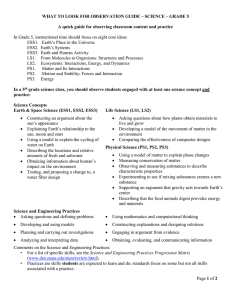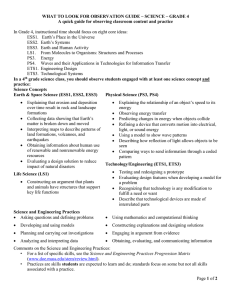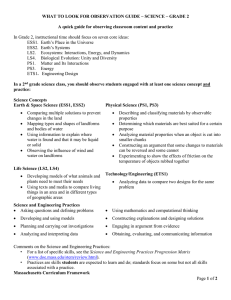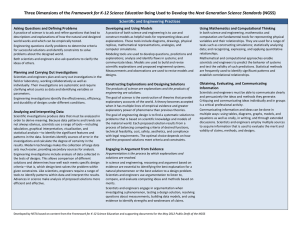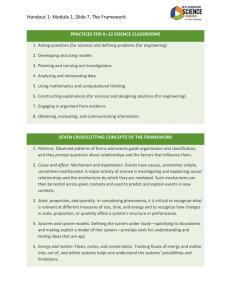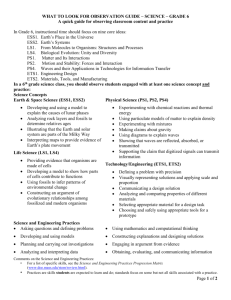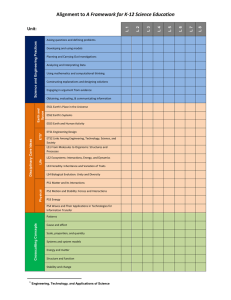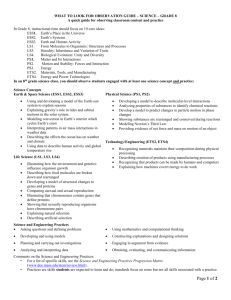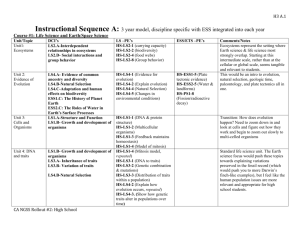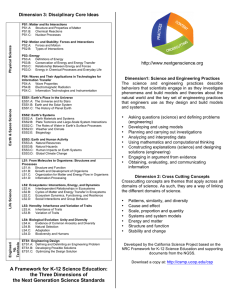NGSS - Community Resources for Science
advertisement
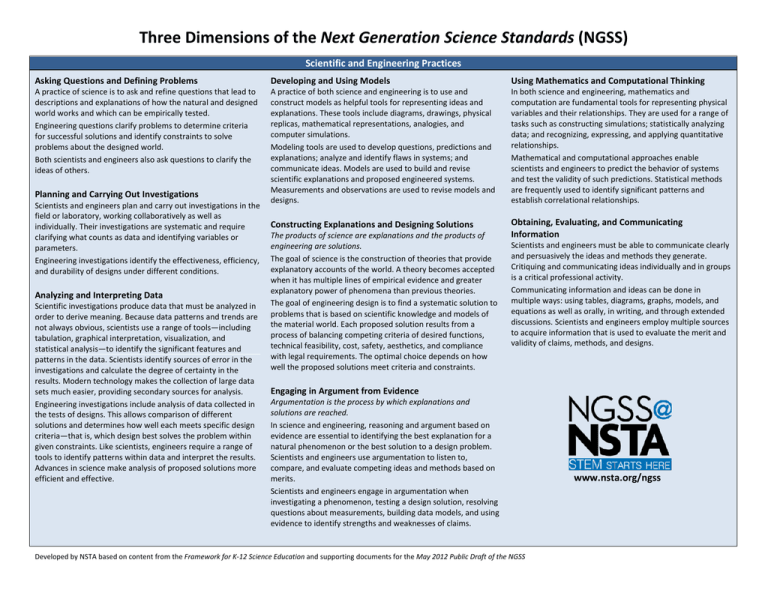
Three Dimensions of the Next Generation Science Standards (NGSS) Scientific and Engineering Practices Asking Questions and Defining Problems A practice of science is to ask and refine questions that lead to descriptions and explanations of how the natural and designed world works and which can be empirically tested. Engineering questions clarify problems to determine criteria for successful solutions and identify constraints to solve problems about the designed world. Both scientists and engineers also ask questions to clarify the ideas of others. Planning and Carrying Out Investigations Scientists and engineers plan and carry out investigations in the field or laboratory, working collaboratively as well as individually. Their investigations are systematic and require clarifying what counts as data and identifying variables or parameters. Engineering investigations identify the effectiveness, efficiency, and durability of designs under different conditions. Analyzing and Interpreting Data Scientific investigations produce data that must be analyzed in order to derive meaning. Because data patterns and trends are not always obvious, scientists use a range of tools—including tabulation, graphical interpretation, visualization, and statistical analysis—to identify the significant features and patterns in the data. Scientists identify sources of error in the investigations and calculate the degree of certainty in the results. Modern technology makes the collection of large data sets much easier, providing secondary sources for analysis. Engineering investigations include analysis of data collected in the tests of designs. This allows comparison of different solutions and determines how well each meets specific design criteria—that is, which design best solves the problem within given constraints. Like scientists, engineers require a range of tools to identify patterns within data and interpret the results. Advances in science make analysis of proposed solutions more efficient and effective. Developing and Using Models Using Mathematics and Computational Thinking Constructing Explanations and Designing Solutions Obtaining, Evaluating, and Communicating Information A practice of both science and engineering is to use and construct models as helpful tools for representing ideas and explanations. These tools include diagrams, drawings, physical replicas, mathematical representations, analogies, and computer simulations. Modeling tools are used to develop questions, predictions and explanations; analyze and identify flaws in systems; and communicate ideas. Models are used to build and revise scientific explanations and proposed engineered systems. Measurements and observations are used to revise models and designs. The products of science are explanations and the products of engineering are solutions. The goal of science is the construction of theories that provide explanatory accounts of the world. A theory becomes accepted when it has multiple lines of empirical evidence and greater explanatory power of phenomena than previous theories. The goal of engineering design is to find a systematic solution to problems that is based on scientific knowledge and models of the material world. Each proposed solution results from a process of balancing competing criteria of desired functions, technical feasibility, cost, safety, aesthetics, and compliance with legal requirements. The optimal choice depends on how well the proposed solutions meet criteria and constraints. In both science and engineering, mathematics and computation are fundamental tools for representing physical variables and their relationships. They are used for a range of tasks such as constructing simulations; statistically analyzing data; and recognizing, expressing, and applying quantitative relationships. Mathematical and computational approaches enable scientists and engineers to predict the behavior of systems and test the validity of such predictions. Statistical methods are frequently used to identify significant patterns and establish correlational relationships. Scientists and engineers must be able to communicate clearly and persuasively the ideas and methods they generate. Critiquing and communicating ideas individually and in groups is a critical professional activity. Communicating information and ideas can be done in multiple ways: using tables, diagrams, graphs, models, and equations as well as orally, in writing, and through extended discussions. Scientists and engineers employ multiple sources to acquire information that is used to evaluate the merit and validity of claims, methods, and designs. Engaging in Argument from Evidence Argumentation is the process by which explanations and solutions are reached. In science and engineering, reasoning and argument based on evidence are essential to identifying the best explanation for a natural phenomenon or the best solution to a design problem. Scientists and engineers use argumentation to listen to, compare, and evaluate competing ideas and methods based on merits. Scientists and engineers engage in argumentation when investigating a phenomenon, testing a design solution, resolving questions about measurements, building data models, and using evidence to identify strengths and weaknesses of claims. Developed by NSTA based on content from the Framework for K-12 Science Education and supporting documents for the May 2012 Public Draft of the NGSS www.nsta.org/ngss Disciplinary Core Ideas in Physical Science PS1: Matter and Its Interactions PS1.A: Structure and Properties of Matter PS1.B: Chemical Reactions PS1.C: Nuclear Processes PS2: Motion and Stability: Forces and Interactions PS2.A: Forces and Motion PS2.B: Types of Interactions PS2.C: Stability and Instability in Physical Systems PS3: Energy PS3.A: Definitions of Energy PS3.B: Conservation of Energy and Energy Transfer PS3.C: Relationship Between Energy and Forces PS3.D: Energy in Chemical Processes and Everyday Life PS4: Waves and Their Applications in Technologies for Information Transfer PS4.A: Wave Properties PS4.B: Electromagnetic Radiation PS4.C: Information Technologies and Instrumentation Disciplinary Core Ideas in Life Science LS1: From Molecules to Organisms: Structures and Processes LS1.A: Structure and Function LS1.B: Growth and Development of Organisms LS1.C: Organization for Matter and Energy Flow in Organisms LS1.D: Information Processing LS2: Ecosystems: Interactions, Energy, and Dynamics LS2.A: Interdependent Relationships in Ecosystems LS2.B: Cycles of Matter and Energy Transfer in Ecosystems LS2.C: Ecosystem Dynamics, Functioning, and Resilience LS2.D: Social Interactions and Group Behavior LS3: Heredity: Inheritance and Variation of Traits LS3.A: Inheritance of Traits LS3.B: Variation of Traits Disciplinary Core Ideas in Earth and Space Science ESS1: Earth’s Place in the Universe ESS1.A: The Universe and Its Stars ESS1.B: Earth and the Solar System ESS1.C: The History of Planet Earth ESS2: Earth’s Systems ESS2.A: Earth Materials and Systems ESS2.B: Plate Tectonics and Large-Scale System Interactions ESS2.C: The Roles of Water in Earth’s Surface Processes ESS2.D: Weather and Climate ESS2.E: Biogeology Disciplinary Core Ideas in Engineering, Technology, and the Application of Science ETS1: Engineering Design ETS1.A: Defining and Delimiting an Engineering Problem ETS1.B: Developing Possible Solutions ETS1.C: Optimizing the Design Solution ETS2: Links Among Engineering, Technology, Science, and Society ETS2.A: Interdependence of Science, Engineering, and Technology ETS2.B: Influence of Engineering, Technology, and Science on Society and the Natural World ESS3: Earth and Human Activity ESS3.A: Natural Resources ESS3.B: Natural Hazards ESS3.C: Human Impacts on Earth Systems ESS3.D: Global Climate Change LS4: Biological Evolution: Unity and Diversity LS4.A: Evidence of Common Ancestry and Diversity LS4.B: Natural Selection LS4.C: Adaptation LS4.D: Biodiversity and Humans Crosscutting Concepts Patterns Observed patterns of forms and events guide organization and classification, and they prompt questions about relationships and the factors that influence them. Cause and Effect: Mechanism and Explanation Events have causes, sometimes simple, sometimes multifaceted. A major activity of science is investigating and explaining causal relationships and the mechanisms by which they are mediated. Such mechanisms can then be tested across given contexts and used to predict and explain events in new contexts. Scale, Proportion, and Quantity In considering phenomena, it is critical to recognize what is relevant at different measures of size, time, and energy and to recognize how changes in scale, proportion, or quantity affect a system’s structure or performance. Systems and System Models Defining the system under study—specifying its boundaries and making explicit a model of that system—provides tools for understanding and testing ideas that are applicable throughout science and engineering. Energy and Matter: Flows, Cycles, and Conservation Tracking fluxes of energy and matter into, out of, and within systems helps one understand the systems’ possibilities and limitations. Structure and Function The way in which an object or living thing is shaped and its substructure determine many of its properties and functions. Stability and Change For natural and built systems alike, conditions of stability and determinants of rates of change or evolution of a system are critical elements of study. Developed by NSTA based on content from the Framework for K-12 Science Education and supporting documents for the May 2012 Public Draft of the NGSS
